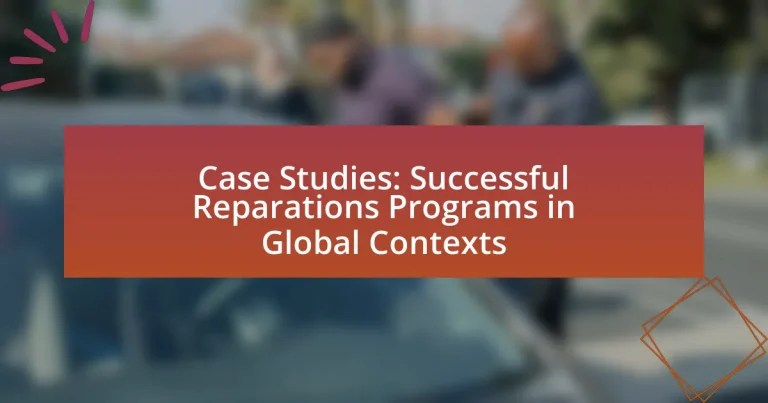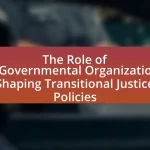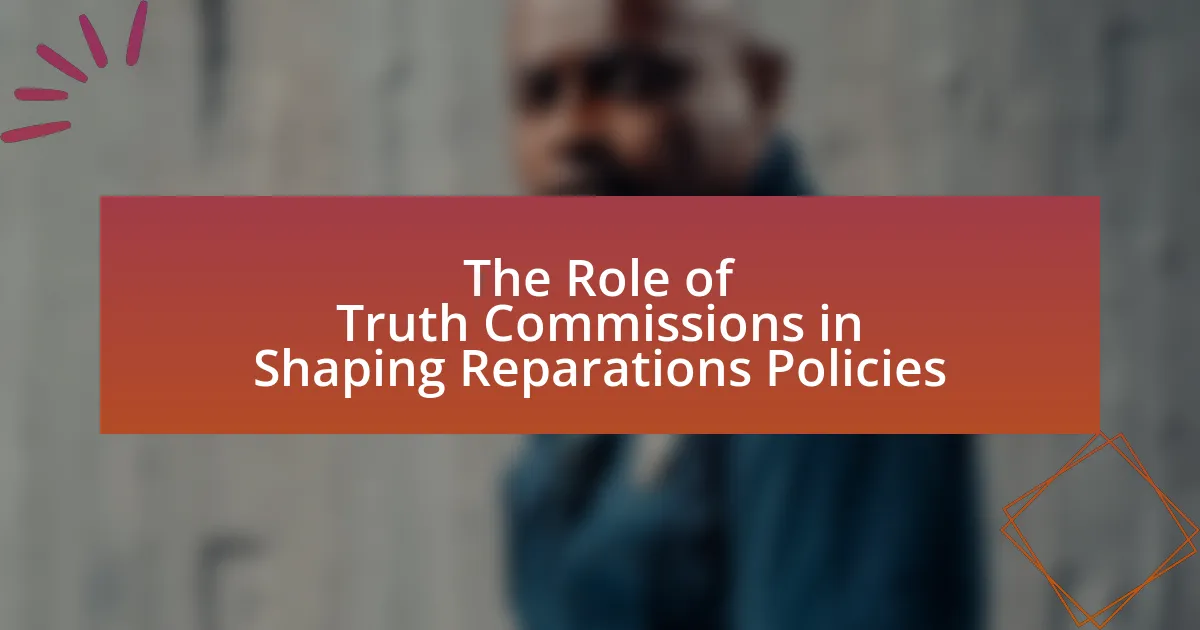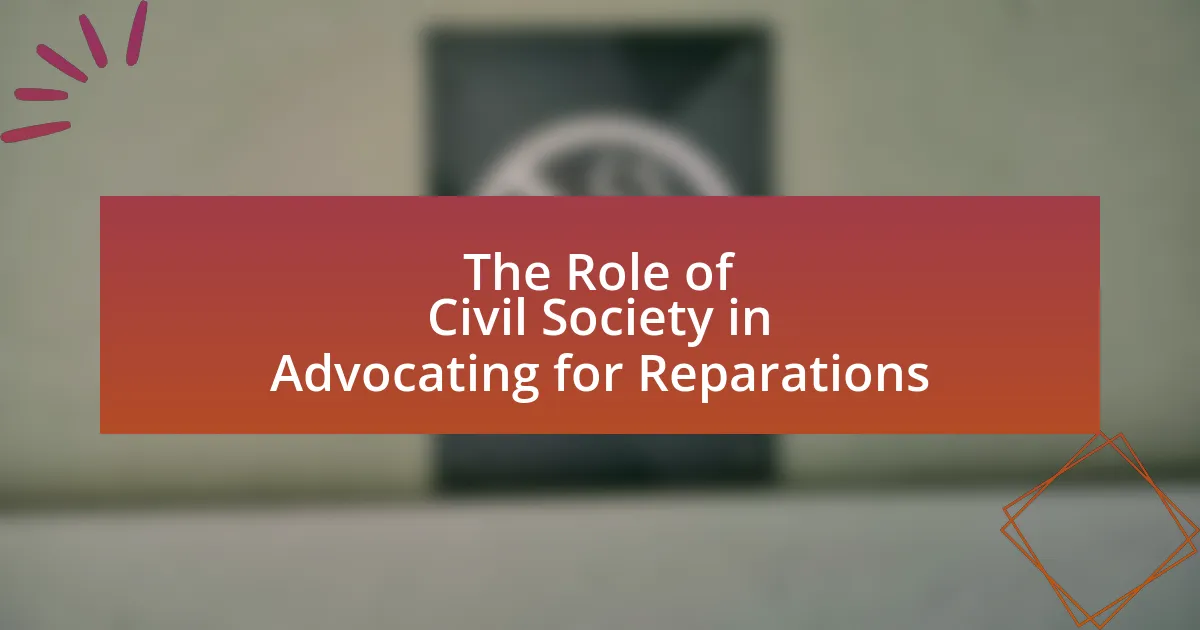Reparations programs are initiatives aimed at compensating individuals or communities for historical injustices, such as slavery and systemic discrimination. This article examines notable case studies of successful reparations programs globally, including Germany’s reparations to Holocaust survivors and South Africa’s post-apartheid initiatives. It discusses the key components of effective reparations, the influence of cultural and historical factors, and the challenges faced during implementation. Additionally, the article highlights the goals of reparations programs, their impact on affected communities, and best practices for designing and advocating for these initiatives.
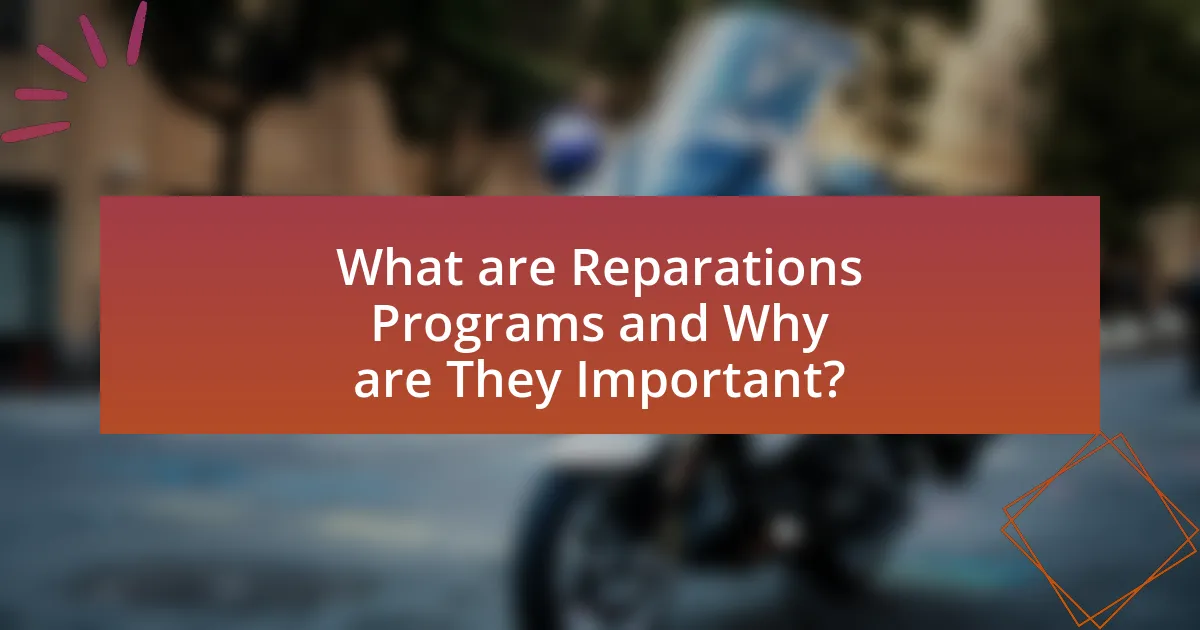
What are Reparations Programs and Why are They Important?
Reparations programs are initiatives designed to compensate individuals or communities for historical injustices, particularly those related to slavery, colonialism, and systemic discrimination. These programs are important because they aim to address the long-lasting economic, social, and psychological impacts of such injustices, promoting healing and reconciliation. For instance, the reparations paid to Holocaust survivors by Germany serve as a concrete example, where financial compensation and social services were provided to acknowledge the atrocities committed during World War II. This not only assists survivors but also fosters a societal recognition of past wrongs, contributing to a more equitable future.
How do Reparations Programs function in different contexts?
Reparations programs function by providing compensation or restitution to groups harmed by historical injustices, and their implementation varies significantly across different contexts. For instance, in South Africa, the Truth and Reconciliation Commission facilitated reparations for victims of apartheid through financial compensation and social services, aiming to promote healing and reconciliation. In contrast, the United States has seen various proposals for reparations for African Americans, focusing on financial compensation, educational opportunities, and community investments, but lacks a formalized national program. Additionally, Germany’s reparations to Holocaust survivors involved direct payments and social benefits, reflecting a commitment to acknowledging and addressing past atrocities. Each context demonstrates unique approaches tailored to specific historical grievances and societal needs, highlighting the complexity and diversity of reparations initiatives globally.
What are the key components of successful Reparations Programs?
Successful reparations programs typically include acknowledgment of past injustices, financial compensation, community investment, and policy reforms. Acknowledgment involves formally recognizing the harm done to affected communities, which is crucial for healing and reconciliation. Financial compensation provides direct monetary support to individuals or communities impacted by historical injustices, as seen in programs like the U.S. government’s reparations for Japanese Americans interned during World War II. Community investment focuses on improving infrastructure, education, and health services in affected areas, exemplified by South Africa’s post-apartheid reparations initiatives. Lastly, policy reforms aim to address systemic inequalities and prevent future injustices, as demonstrated by Germany’s reparations to Holocaust survivors, which included legal and social reforms. These components collectively contribute to the effectiveness and success of reparations programs.
How do cultural and historical factors influence Reparations Programs?
Cultural and historical factors significantly influence Reparations Programs by shaping societal perceptions of justice and accountability. For instance, in post-apartheid South Africa, the Truth and Reconciliation Commission highlighted the importance of acknowledging historical injustices, which facilitated a national dialogue on reparations. This cultural emphasis on reconciliation influenced the design of reparations, focusing on restorative justice rather than punitive measures. Additionally, historical contexts, such as the legacy of slavery in the United States, have led to ongoing debates about reparations, reflecting deep-rooted cultural narratives around race and inequality. These factors underscore how cultural values and historical experiences inform the objectives, structures, and public support for reparations initiatives.
What are the goals of Reparations Programs?
The goals of Reparations Programs primarily include acknowledging historical injustices, providing compensation to affected communities, and promoting social and economic equity. These programs aim to address the long-term impacts of systemic discrimination and violence, such as slavery, colonization, and apartheid. For instance, the reparations program in South Africa post-apartheid sought to redress the socio-economic disparities created by decades of racial segregation, demonstrating a commitment to healing and reconciliation. Additionally, reparations can serve as a means to foster awareness and education about historical injustices, thereby contributing to societal transformation and preventing future discrimination.
How do Reparations Programs aim to address historical injustices?
Reparations programs aim to address historical injustices by providing compensation and acknowledgment to marginalized groups affected by systemic discrimination and exploitation. These programs often include financial payments, land restitution, educational opportunities, and public apologies, which serve to recognize the wrongs of the past and promote healing. For instance, South Africa’s Truth and Reconciliation Commission offered reparations to victims of apartheid, highlighting the importance of both financial support and societal acknowledgment in rectifying historical grievances. Such initiatives are designed to foster social equity and contribute to the restoration of dignity for affected communities.
What impact do Reparations Programs have on affected communities?
Reparations programs have a significant positive impact on affected communities by addressing historical injustices and providing financial and social support. These programs can lead to improved economic conditions, enhanced community cohesion, and increased access to education and healthcare. For instance, the reparations program in South Africa post-apartheid allocated funds for housing, education, and health services, which contributed to reducing poverty levels among previously marginalized groups. Additionally, studies show that reparations can foster reconciliation and healing, as seen in the case of Germany’s reparations to Holocaust survivors, which not only provided financial compensation but also acknowledged the suffering endured, promoting social justice and historical recognition.

What are Notable Case Studies of Successful Reparations Programs?
Notable case studies of successful reparations programs include the reparations provided to Holocaust survivors by Germany, which began in the 1950s and involved financial compensation, social services, and pensions, totaling over $89 billion by 2021. Another significant example is the reparations program in South Africa post-apartheid, which included the Truth and Reconciliation Commission that offered reparations to victims of human rights violations, distributing approximately $3.5 million to individuals and communities. Additionally, the U.S. government’s reparations to Japanese Americans interned during World War II, which included a formal apology and $20,000 payments to each survivor, exemplifies a successful reparations initiative. These cases demonstrate effective frameworks for addressing historical injustices through financial compensation and acknowledgment of wrongs.
How did South Africa implement its Reparations Program post-apartheid?
South Africa implemented its Reparations Program post-apartheid through the establishment of the Truth and Reconciliation Commission (TRC) in 1995, which aimed to address the injustices of apartheid. The TRC provided a platform for victims to share their experiences and seek acknowledgment, while also offering reparations in the form of financial compensation, educational assistance, and community development projects. The government allocated approximately 1.2 billion rand for reparations, benefiting thousands of victims and their families, thereby reinforcing the commitment to healing and reconciliation in a divided society.
What were the main challenges faced during the implementation?
The main challenges faced during the implementation of reparations programs included political resistance, inadequate funding, and difficulties in establishing eligibility criteria. Political resistance often stemmed from opposing views on historical injustices, which hindered consensus and slowed progress. Inadequate funding limited the scope and effectiveness of reparations initiatives, as seen in various case studies where financial resources were insufficient to meet the needs of affected communities. Additionally, establishing clear eligibility criteria posed challenges, as determining who qualifies for reparations can be complex and contentious, leading to disputes and delays in program rollout.
What outcomes were achieved through the South African Reparations Program?
The South African Reparations Program achieved several significant outcomes, including financial compensation for victims of apartheid, the establishment of the Truth and Reconciliation Commission (TRC), and the promotion of national healing and reconciliation. Financial compensation was awarded to approximately 19,000 victims, with the government allocating around 1.5 billion rand for reparations. The TRC played a crucial role in documenting human rights violations and fostering dialogue, which contributed to societal healing. Additionally, the program aimed to address systemic inequalities through initiatives in education and housing, thereby promoting social justice and integration. These outcomes collectively aimed to acknowledge past injustices and support the rebuilding of a more equitable society.
What lessons can be learned from the German Reparations to Holocaust Survivors?
The German reparations to Holocaust survivors demonstrate the importance of acknowledging historical injustices and providing compensation as a means of reconciliation. These reparations, initiated in the 1950s, involved financial payments, social services, and recognition of suffering, which helped to restore dignity to survivors and their families. The program highlighted that reparations can facilitate healing and foster dialogue between victims and perpetrators, as evidenced by the establishment of the Claims Conference, which negotiated compensation agreements. Furthermore, the German model illustrates that reparations can be structured to include both individual and collective forms of compensation, addressing the needs of diverse survivor populations. This approach underscores the necessity of a comprehensive framework that considers the long-term impacts of trauma and the importance of sustained commitment from governments to fulfill reparative obligations.
How did the German government structure its Reparations Program?
The German government structured its Reparations Program primarily through the Treaty of Versailles, which mandated reparations payments to the Allied powers following World War I. The program was organized into specific payment schedules and amounts, initially set at 132 billion gold marks, with the intention of compensating for war damages. The German government established the Reparations Commission to oversee the payment process, which included both cash payments and in-kind contributions such as coal and other resources. This structure was further complicated by economic challenges, leading to adjustments in payment terms over time, including the Dawes Plan in 1924 and the Young Plan in 1929, which aimed to ease the financial burden on Germany while ensuring compliance with reparations obligations.
What were the long-term effects of these reparations on survivors and their descendants?
The long-term effects of reparations on survivors and their descendants include improved economic stability, enhanced social recognition, and psychological healing. For instance, in the case of Japanese American internment reparations, the U.S. government provided financial compensation and formal apologies, which contributed to a stronger sense of identity and community cohesion among survivors and their families. Studies indicate that such reparations can lead to increased educational attainment and economic opportunities for descendants, as seen in the case of Holocaust reparations, where financial support has facilitated better access to resources and opportunities. Additionally, reparations often foster intergenerational dialogue about historical injustices, promoting awareness and advocacy for social justice, which can positively influence descendants’ perspectives and actions in society.
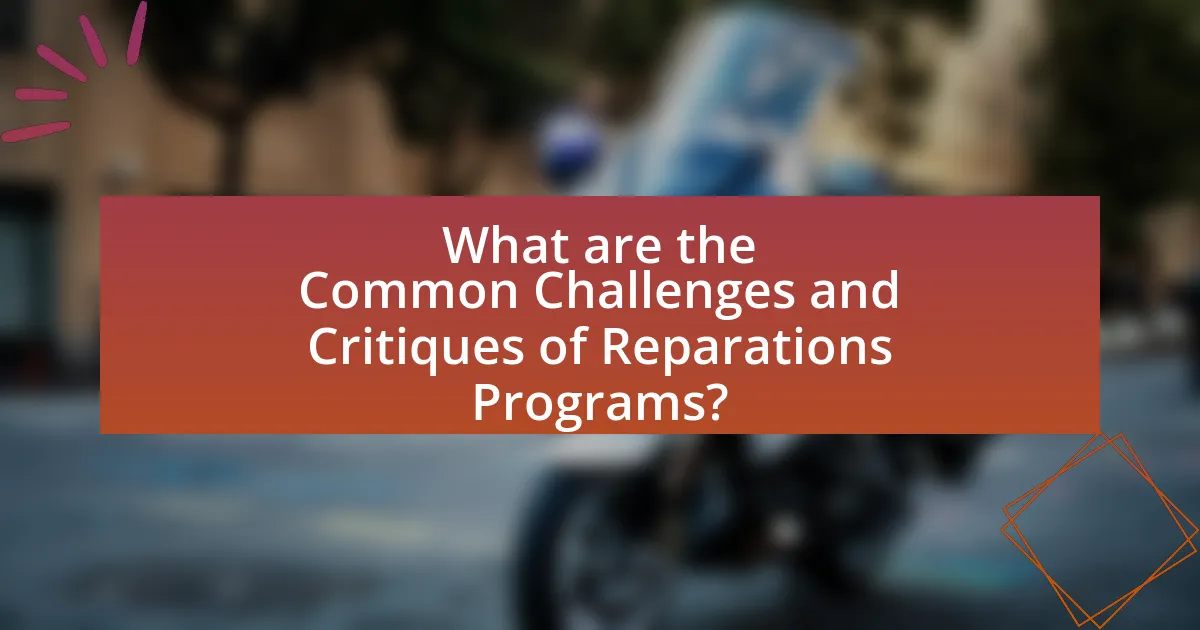
What are the Common Challenges and Critiques of Reparations Programs?
Common challenges and critiques of reparations programs include issues of feasibility, political resistance, and the complexity of determining eligibility. Feasibility concerns arise from the financial burden on governments, as seen in the case of the United States, where estimates for reparations to African Americans could reach trillions of dollars. Political resistance often stems from differing public opinions and the belief that reparations may create further division rather than healing, as highlighted by debates in various countries. Additionally, the complexity of determining who qualifies for reparations can lead to disputes and dissatisfaction, exemplified by the challenges faced in the reparations programs for Japanese Americans interned during World War II, where not all affected individuals received compensation. These factors collectively hinder the implementation and acceptance of reparations initiatives.
What are the main criticisms of Reparations Programs?
The main criticisms of Reparations Programs include the arguments that they are financially impractical, create division among communities, and fail to address systemic issues. Critics argue that the financial burden of reparations could be overwhelming for governments, as seen in discussions surrounding the estimated costs of reparations for slavery in the United States, which could reach trillions of dollars. Additionally, opponents contend that reparations may exacerbate racial tensions by highlighting historical grievances rather than fostering unity. Furthermore, some argue that reparations do not tackle the root causes of inequality, such as education and economic opportunity, which are essential for long-term change. These criticisms highlight the complexities and challenges associated with implementing effective reparations programs.
How do opponents argue against the effectiveness of Reparations Programs?
Opponents argue against the effectiveness of Reparations Programs by claiming they fail to address the root causes of inequality and may create further division within society. Critics assert that financial compensation does not equate to true justice or reconciliation, as it does not rectify systemic issues such as discrimination and social disenfranchisement. Additionally, opponents highlight that reparations can be seen as a burden on taxpayers, particularly those who may not have directly benefited from historical injustices. They also argue that the implementation of such programs can be logistically complex and may lead to disputes over eligibility and the amount of compensation, ultimately undermining their intended purpose.
What are the ethical considerations surrounding Reparations Programs?
Ethical considerations surrounding Reparations Programs include justice, accountability, and the impact on societal cohesion. Justice is a primary concern, as reparations aim to acknowledge and rectify historical injustices, such as slavery or colonialism, by compensating affected communities. Accountability involves recognizing the responsibility of governments or institutions for past wrongs, which can foster a sense of moral obligation to address these issues. Additionally, the potential for societal division or conflict arises when determining who qualifies for reparations and how they are distributed, as seen in cases like the U.S. reparations debate for African Americans. These considerations highlight the complexity of implementing reparations in a way that is perceived as fair and just by all stakeholders involved.
How can successful Reparations Programs be designed and implemented?
Successful reparations programs can be designed and implemented by ensuring they are inclusive, evidence-based, and community-driven. These programs should begin with comprehensive assessments of historical injustices and their impacts on affected communities, as seen in the case of South Africa’s Truth and Reconciliation Commission, which facilitated dialogue and acknowledgment of past wrongs.
Additionally, successful programs must incorporate financial compensation, educational opportunities, and social services tailored to the specific needs of the impacted populations, similar to the reparations initiatives in Germany for Holocaust survivors, which included direct payments and social support.
Engagement with affected communities throughout the design and implementation process is crucial, as demonstrated by the reparations efforts in the United States for Japanese Americans interned during World War II, where community input shaped the compensation framework.
Finally, transparency and accountability mechanisms should be established to monitor the effectiveness of the reparations programs, ensuring that they meet their intended goals and adapt to feedback from beneficiaries.
What best practices should be followed in creating Reparations Programs?
Best practices for creating Reparations Programs include ensuring community involvement, establishing clear objectives, and providing comprehensive support. Community involvement is crucial as it fosters trust and ensures that the needs of those affected are accurately represented. For instance, the South African Truth and Reconciliation Commission involved victims in the process, which helped to address historical grievances effectively. Establishing clear objectives allows for measurable outcomes, as seen in the U.S. government’s reparations for Japanese Americans interned during World War II, which included financial compensation and public acknowledgment of wrongdoing. Comprehensive support should encompass financial, educational, and social services, as demonstrated by the reparations program in Germany for Holocaust survivors, which provided various forms of assistance to help rebuild lives. These practices enhance the effectiveness and legitimacy of reparations initiatives.
How can stakeholder engagement enhance the effectiveness of Reparations Programs?
Stakeholder engagement can enhance the effectiveness of Reparations Programs by ensuring that the voices and needs of affected communities are prioritized in the design and implementation of these initiatives. Engaging stakeholders, such as community leaders, affected individuals, and advocacy groups, fosters trust and transparency, which are critical for the acceptance and success of reparations efforts. For instance, the South African Truth and Reconciliation Commission involved various stakeholders, leading to a more comprehensive understanding of the injustices faced and resulting in reparations that were more aligned with the community’s needs. This participatory approach not only improves the relevance of the reparations but also increases community buy-in, ultimately leading to more sustainable outcomes.
What practical steps can communities take to advocate for Reparations?
Communities can advocate for reparations by organizing educational campaigns to raise awareness about historical injustices and their ongoing impacts. These campaigns can include workshops, seminars, and community discussions that highlight the need for reparations, supported by historical data such as the 1865 Freedmen’s Bureau report, which documented the economic disparities faced by formerly enslaved individuals.
Additionally, communities can form coalitions with local organizations to create a unified front, leveraging collective resources to push for policy changes at local, state, and national levels. For instance, the 2020 California Task Force to Study and Develop Reparations Proposals for African Americans was established as a direct result of community advocacy, demonstrating the effectiveness of organized efforts.
Communities should also engage in lobbying efforts, contacting legislators to advocate for reparative policies, and participating in public hearings to voice their demands. The success of the 1990s reparations movement in the United States, which led to compensation for Japanese Americans interned during World War II, illustrates the impact of sustained advocacy and legislative engagement.
Finally, communities can document personal stories and testimonies to humanize the reparations movement, creating a compelling narrative that emphasizes the need for justice and restitution. This approach was effectively utilized in the Truth and Reconciliation Commission in South Africa, which highlighted personal accounts of apartheid’s impact, thereby strengthening the case for reparations.
